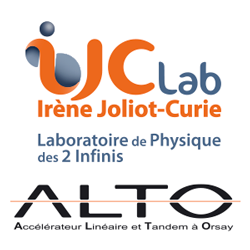Contact : D. Verney verney@ipno.in2p3.fr
Commissioning with radioactive beam in 2012.
MOTIVATION
The BEDO setup is dedicated for nuclear structure studies after beta decay of neutron rich fission isotopes produced at ALTO. Nuclei in the mass region of N=50 and close to the Z=28 shell closure have attracted many experimental and theoretical interest at BEDO. Studying the gap between the n1g9/2 and n2d5/2 orbitals which corresponds to the N=50 shell effect is essential to understand the formation of this magic closure ― and more generally the origin of the strong gaps associated to spin-orbit magic numbers throughout the whole nuclide chart, to which 3-body terms of the N-N interaction are now thought to play a key role. The region close to N=82 is also well investigated at BEDO. The region beyond 132Sn is an ideal testing ground for shell model, due to the pure neutron valence. Theoretical predictions have suggested that in the second f7/2 neutron shell, the three-body forces may lead to a shell closure at N=90, similarly to the first f7/2 shell closure. Fast timing measurements will be also investigated in the lanthanide region. With the development of targets devoted to fusion evaporation reactions the study of other regions will be possible. A letter of intent has been proposed for the study of the branching ratios in the decay of 10C and 14O.
METHODOLOGY
BEDO (BEta Decay studies at Orsay) is a state-of-the-art movable-tape-based experimental setup currently operated at ALTO. The opportunity to build a more complex detection system was offered by the completion of a new set a secondary beam line sections at ALTO. The trajectory of the tape in BEDO is chosen to maximize the space available around the beam collection point, ideally 4p, allowing the closest positioning of different types of detectors and maximal efficiency. The mechanical support was also designed to host various detector assemblies : the collection point is surrounded by cylindrical plastic scintillator for the b trigger, five Ge detectors in close geometry can be placed at BEDO, five plastic scintillators are placed in front of each five Ge detector end cap, acting as Bremsstrahlung vetoing, and BGO detectors surrounding the Ge detectors act as active shielding and for Compton suppression.
PERSPECTIVE
The use of 4 Exogam clovers with their BGO shielding from GANIL, in order to increase the efficiency.
The development of other targets other sources to extend the region accessible at BEDO












